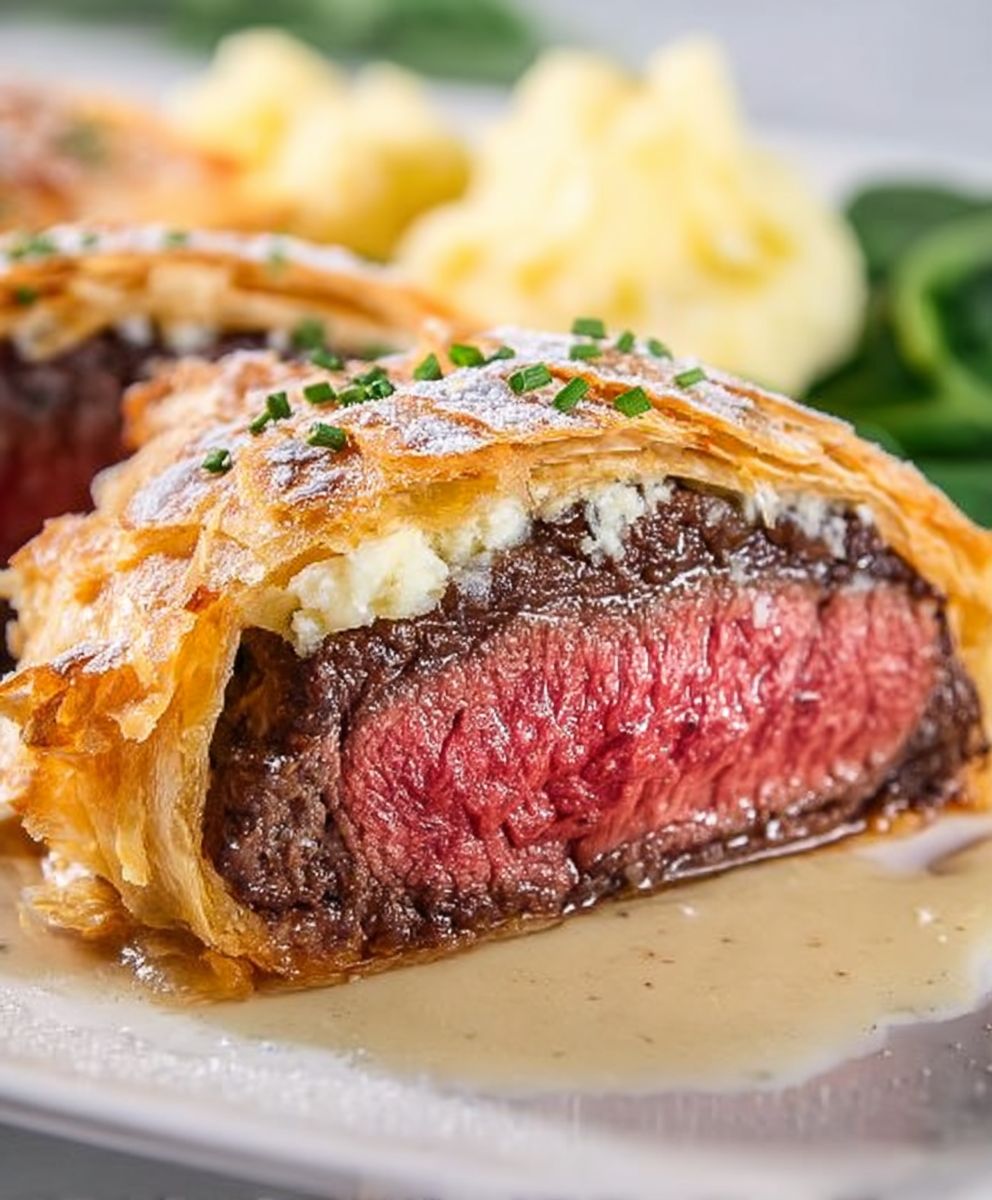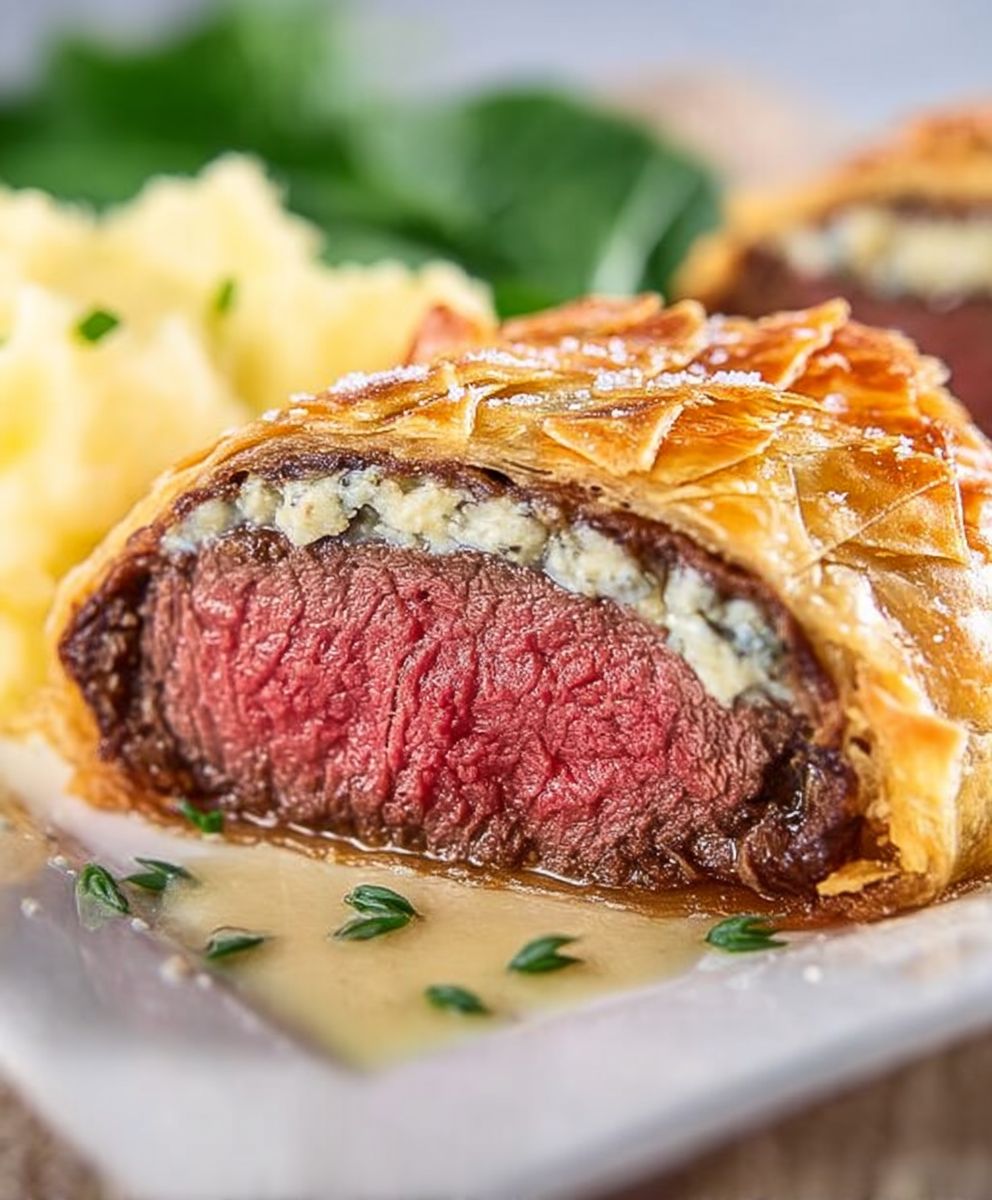Beef Wellington Mushroom Pate: Prepare to embark on a culinary adventure that will elevate your appetizer game to a whole new level! Imagine the rich, savory flavors of a classic Beef Wellington, deconstructed and transformed into a decadent, spreadable delight. This isn’t just any pate; it’s a symphony of textures and tastes that will have your guests begging for the recipe.
The inspiration behind this Beef Wellington Mushroom Pate stems from the iconic Beef Wellington itself, a dish steeped in history and often associated with grand celebrations. While its exact origins are debated, many believe it was created to honor the Duke of Wellington. Our pate pays homage to this culinary masterpiece, capturing its essence in a more approachable and shareable form.
What makes this pate so irresistible? It’s the perfect marriage of earthy mushrooms, tender beef, and a hint of luxurious truffle oil (optional, but highly recommended!). The smooth, creamy texture is incredibly satisfying, and the robust flavors are guaranteed to tantalize your taste buds. Whether you’re hosting a sophisticated cocktail party or simply looking for a special treat to enjoy at home, this Beef Wellington Mushroom Pate is sure to impress. It’s surprisingly easy to make, and the results are simply divine. Get ready to spread the love (and the pate!)!
Ingredients:
- For the Duxelles (Mushroom Paste):
- 1.5 lbs mixed mushrooms (cremini, shiitake, oyster), finely chopped
- 2 tbsp olive oil
- 4 tbsp unsalted butter
- 1 large shallot, finely minced
- 2 cloves garlic, minced
- 1/4 cup dry sherry or Madeira wine
- 2 tbsp fresh thyme leaves, chopped
- 1 tbsp fresh parsley, chopped
- Salt and freshly ground black pepper to taste
- For the Beef Wellington:
- 3 lb center-cut beef tenderloin roast, trimmed
- 2 tbsp olive oil
- Salt and freshly ground black pepper to taste
- 2 tbsp Dijon mustard
- 1 lb prosciutto, thinly sliced
- 1 package (17.3 oz) puff pastry sheets, thawed
- 1 large egg, beaten (for egg wash)
- Flaky sea salt, for sprinkling (optional)
Preparing the Duxelles (Mushroom Paste)
- Sauté the Aromatics: In a large skillet over medium heat, heat the olive oil and butter until the butter is melted and shimmering. Add the minced shallot and cook until softened and translucent, about 5 minutes. Add the minced garlic and cook for another minute until fragrant, being careful not to burn it.
- Cook the Mushrooms: Add the finely chopped mushrooms to the skillet. It’s important to use a large skillet, or work in batches, to avoid overcrowding the pan. Overcrowding will steam the mushrooms instead of allowing them to brown properly. Cook, stirring occasionally, until the mushrooms release their moisture and then begin to brown, about 15-20 minutes. The mushrooms should be significantly reduced in volume and most of the liquid should have evaporated.
- Deglaze with Sherry: Pour in the dry sherry or Madeira wine and scrape up any browned bits from the bottom of the skillet. This adds a depth of flavor to the duxelles. Cook until the wine has almost completely evaporated, about 2-3 minutes.
- Add Herbs and Season: Stir in the chopped fresh thyme and parsley. Season generously with salt and freshly ground black pepper to taste. Remember that the prosciutto will also be salty, so adjust accordingly.
- Cool Completely: Remove the skillet from the heat and transfer the duxelles to a bowl. Allow it to cool completely before using. This is crucial, as warm duxelles will melt the puff pastry later on. You can even prepare the duxelles a day in advance and store it in the refrigerator.
Preparing the Beef Tenderloin
- Sear the Beef: Pat the beef tenderloin dry with paper towels. This is essential for achieving a good sear. Season generously with salt and freshly ground black pepper. Heat the olive oil in a large, oven-safe skillet (cast iron is ideal) over high heat until it’s smoking hot. Sear the beef tenderloin on all sides until it’s deeply browned, about 2-3 minutes per side. The goal is to create a flavorful crust, not to cook the beef through.
- Cool the Beef: Remove the beef tenderloin from the skillet and place it on a wire rack set over a baking sheet. Allow it to cool completely. This is another crucial step, as warm beef will also melt the puff pastry. You can speed up the cooling process by placing it in the refrigerator for about 30 minutes.
- Brush with Mustard: Once the beef tenderloin is completely cool, brush it evenly with Dijon mustard. The mustard adds flavor and helps the duxelles adhere to the beef.
Assembling the Beef Wellington
- Wrap with Prosciutto: Lay out a large sheet of plastic wrap on a clean work surface. Overlap the prosciutto slices on the plastic wrap to create a rectangle large enough to completely wrap the beef tenderloin. Spread the cooled duxelles evenly over the prosciutto, creating a thin, even layer.
- Encase the Beef: Place the mustard-coated beef tenderloin on top of the duxelles-covered prosciutto. Using the plastic wrap to help you, tightly roll the prosciutto and duxelles around the beef tenderloin, forming a log. Twist the ends of the plastic wrap tightly to seal and refrigerate for at least 30 minutes, or up to 2 hours. This helps the beef hold its shape and allows the flavors to meld.
- Prepare the Puff Pastry: On a lightly floured surface, unfold the thawed puff pastry sheets. If necessary, gently roll them out to create a rectangle large enough to completely enclose the beef tenderloin. You may need to overlap two sheets of puff pastry and press the seam together.
- Wrap with Puff Pastry: Remove the beef tenderloin from the refrigerator and unwrap it from the plastic wrap. Place the beef tenderloin in the center of the puff pastry. Brush the edges of the puff pastry with the beaten egg. Fold the puff pastry over the beef tenderloin, completely enclosing it. Trim any excess pastry and crimp the edges with a fork to seal.
- Decorate (Optional): Use the excess puff pastry to create decorative shapes, such as leaves or flowers. Attach them to the top of the Wellington with a little bit of the beaten egg.
- Egg Wash and Chill: Brush the entire surface of the puff pastry with the remaining beaten egg. This will give it a beautiful golden-brown color when baked. Sprinkle with flaky sea salt, if desired. Place the assembled Beef Wellington in the refrigerator for at least 30 minutes before baking. This helps the pastry relax and prevents it from shrinking too much during baking.
Baking the Beef Wellington
- Preheat the Oven: Preheat your oven to 400°F (200°C).
- Bake: Place the Beef Wellington on a baking sheet lined with parchment paper. Bake for 35-45 minutes, or until the puff pastry is golden brown and the internal temperature of the beef reaches 125-130°F (52-54°C) for medium-rare, 130-135°F (54-57°C) for medium, or 135-140°F (57-60°C) for medium-well. Use a meat thermometer to ensure accurate temperature readings.
- Rest: Remove the Beef Wellington from the oven and let it rest for at least 10 minutes before slicing. This allows the juices to redistribute, resulting in a more tender and flavorful roast.
Serving the Beef Wellington
- Slice and Serve: Use a sharp, serrated knife to slice the Beef Wellington into thick slices. Serve immediately.
- Suggested Sides: Beef Wellington is delicious served with roasted vegetables, mashed potatoes, or a red wine reduction sauce.

Conclusion:
This isn’t just a recipe; it’s an experience. The Beef Wellington with Mushroom Pate is a showstopper, a culinary adventure that will impress your guests and leave you feeling like a true chef. From the flaky, golden-brown pastry to the rich, savory beef tenderloin and the earthy depth of the mushroom pate, every element works in perfect harmony. It’s a dish that elevates any occasion, transforming a simple dinner into a memorable feast.
Why is this Beef Wellington a must-try? Because it’s more than just delicious; it’s an exercise in flavor layering and textural contrast. The tender beef, the crisp pastry, and the creamy pate create a symphony of sensations that will tantalize your taste buds. Plus, mastering this recipe is a badge of honor, a testament to your culinary skills. It’s a dish that demands attention and delivers exceptional results.
But don’t just take my word for it! I encourage you to embark on this culinary journey and discover the magic of Beef Wellington with Mushroom Pate for yourself.
Serving Suggestions and Variations:
This Beef Wellington is fantastic served with a classic red wine reduction sauce. The richness of the sauce complements the beef and pate beautifully. For side dishes, consider roasted asparagus with a squeeze of lemon, creamy mashed potatoes, or a simple green salad with a vinaigrette dressing. These lighter sides will balance the richness of the Wellington.
Looking for variations? You can experiment with different types of mushrooms in the pate. Try adding a mix of shiitake, cremini, and oyster mushrooms for a more complex flavor profile. You could also incorporate a touch of truffle oil or truffle paste into the pate for an extra layer of luxury.
For a vegetarian option, consider replacing the beef tenderloin with a large portobello mushroom cap. Marinate the mushroom in balsamic vinegar and herbs before wrapping it in the pate and pastry.
Another variation involves adding a thin layer of duxelles (finely chopped mushrooms sautéed with shallots and herbs) between the beef and the pate. This will enhance the mushroom flavor and add another layer of moisture.
If you’re short on time, you can use store-bought puff pastry. However, I highly recommend making your own pastry from scratch for the best flavor and texture. It’s a bit more work, but the results are well worth it.
Don’t be intimidated! While Beef Wellington may seem daunting, it’s actually quite manageable if you break it down into steps. Prepare the pate and duxelles (if using) ahead of time. Chill the beef tenderloin thoroughly before wrapping it. And don’t be afraid to ask for help! Enlist a friend or family member to assist with the pastry wrapping.
The key to a perfect Beef Wellington is patience and attention to detail. Take your time, follow the instructions carefully, and don’t be afraid to experiment.
I’m confident that you’ll be amazed by the results. This Beef Wellington with Mushroom Pate is a dish that will impress your guests and leave them wanting more.
So, what are you waiting for? Gather your ingredients, put on your apron, and get ready to create a culinary masterpiece. I can’t wait to hear about your experience! Please share your photos and comments on social media using #BeefWellingtonAdventure. Let’s celebrate the joy of cooking and the deliciousness of this incredible dish together! I’m eager to see your creations and hear about your own personal touches to this classic recipe. Happy cooking!
Beef Wellington Mushroom Pate: A Delicious and Decadent Recipe
Seared beef tenderloin wrapped in mushroom duxelles, prosciutto, and flaky puff pastry. A show-stopping centerpiece for any occasion.
Ingredients
- 1.5 lbs mixed mushrooms (cremini, shiitake, oyster), finely chopped
- 2 tbsp olive oil
- 4 tbsp unsalted butter
- 1 large shallot, finely minced
- 2 cloves garlic, minced
- 1/4 cup dry sherry or Madeira wine
- 2 tbsp fresh thyme leaves, chopped
- 1 tbsp fresh parsley, chopped
- Salt and freshly ground black pepper to taste
- 3 lb center-cut beef tenderloin roast, trimmed
- 2 tbsp olive oil
- Salt and freshly ground black pepper to taste
- 2 tbsp Dijon mustard
- 1 lb prosciutto, thinly sliced
- 1 package (17.3 oz) puff pastry sheets, thawed
- 1 large egg, beaten (for egg wash)
- Flaky sea salt, for sprinkling (optional)
Instructions
- Sauté the Aromatics: In a large skillet over medium heat, heat the olive oil and butter until the butter is melted and shimmering. Add the minced shallot and cook until softened and translucent, about 5 minutes. Add the minced garlic and cook for another minute until fragrant, being careful not to burn it.
- Cook the Mushrooms: Add the finely chopped mushrooms to the skillet. Cook, stirring occasionally, until the mushrooms release their moisture and then begin to brown, about 15-20 minutes. The mushrooms should be significantly reduced in volume and most of the liquid should have evaporated.
- Deglaze with Sherry: Pour in the dry sherry or Madeira wine and scrape up any browned bits from the bottom of the skillet. Cook until the wine has almost completely evaporated, about 2-3 minutes.
- Add Herbs and Season: Stir in the chopped fresh thyme and parsley. Season generously with salt and freshly ground black pepper to taste.
- Cool Completely: Remove the skillet from the heat and transfer the duxelles to a bowl. Allow it to cool completely before using. You can even prepare the duxelles a day in advance and store it in the refrigerator.
- Sear the Beef: Pat the beef tenderloin dry with paper towels. Season generously with salt and freshly ground black pepper. Heat the olive oil in a large, oven-safe skillet (cast iron is ideal) over high heat until it’s smoking hot. Sear the beef tenderloin on all sides until it’s deeply browned, about 2-3 minutes per side.
- Cool the Beef: Remove the beef tenderloin from the skillet and place it on a wire rack set over a baking sheet. Allow it to cool completely. You can speed up the cooling process by placing it in the refrigerator for about 30 minutes.
- Brush with Mustard: Once the beef tenderloin is completely cool, brush it evenly with Dijon mustard.
- Wrap with Prosciutto: Lay out a large sheet of plastic wrap on a clean work surface. Overlap the prosciutto slices on the plastic wrap to create a rectangle large enough to completely wrap the beef tenderloin. Spread the cooled duxelles evenly over the prosciutto, creating a thin, even layer.
- Encase the Beef: Place the mustard-coated beef tenderloin on top of the duxelles-covered prosciutto. Using the plastic wrap to help you, tightly roll the prosciutto and duxelles around the beef tenderloin, forming a log. Twist the ends of the plastic wrap tightly to seal and refrigerate for at least 30 minutes, or up to 2 hours.
- Prepare the Puff Pastry: On a lightly floured surface, unfold the thawed puff pastry sheets. If necessary, gently roll them out to create a rectangle large enough to completely enclose the beef tenderloin. You may need to overlap two sheets of puff pastry and press the seam together.
- Wrap with Puff Pastry: Remove the beef tenderloin from the refrigerator and unwrap it from the plastic wrap. Place the beef tenderloin in the center of the puff pastry. Brush the edges of the puff pastry with the beaten egg. Fold the puff pastry over the beef tenderloin, completely enclosing it. Trim any excess pastry and crimp the edges with a fork to seal.
- Decorate (Optional): Use the excess puff pastry to create decorative shapes, such as leaves or flowers. Attach them to the top of the Wellington with a little bit of the beaten egg.
- Egg Wash and Chill: Brush the entire surface of the puff pastry with the remaining beaten egg. Sprinkle with flaky sea salt, if desired. Place the assembled Beef Wellington in the refrigerator for at least 30 minutes before baking.
- Preheat the Oven: Preheat your oven to 400°F (200°C).
- Bake: Place the Beef Wellington on a baking sheet lined with parchment paper. Bake for 35-45 minutes, or until the puff pastry is golden brown and the internal temperature of the beef reaches 125-130°F (52-54°C) for medium-rare, 130-135°F (54-57°C) for medium, or 135-140°F (57-60°C) for medium-well. Use a meat thermometer to ensure accurate temperature readings.
- Rest: Remove the Beef Wellington from the oven and let it rest for at least 10 minutes before slicing.
- Serve: Slice and serve immediately with your favorite sides.
Notes
- Cooling the duxelles and beef tenderloin completely before assembling is crucial to prevent the puff pastry from melting.
- Refrigerating the wrapped beef tenderloin and assembled Wellington helps the flavors meld and the pastry relax.
- Use a meat thermometer to ensure the beef is cooked to your desired doneness.
- Resting the Wellington after baking allows the juices to redistribute, resulting in a more tender and flavorful roast.

